Contact and Surface 2011
10th International Conference on Surface Effects and Contact Mechanics
21 - 23 September 2011
Malta
Overview
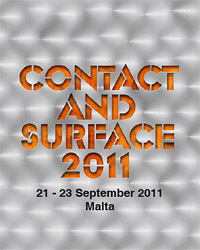 The 10th International Conference on Surface Effects and Contact Mechanics took place in Malta, organised by the University of Groningen, The Netherlands, represented by Professor Jeff De Hosson, and the Wessex Institute of Technology, UK, represented by Professor Carlos Brebbia.
The 10th International Conference on Surface Effects and Contact Mechanics took place in Malta, organised by the University of Groningen, The Netherlands, represented by Professor Jeff De Hosson, and the Wessex Institute of Technology, UK, represented by Professor Carlos Brebbia.
The conference has been held for the last eighteen years in a series of locations throughout the world, starting in Southampton (UK) in 1993, followed by Milan (1995), Oxford (1997), Assisi (1999), Seville (2001), Crete (2003), Bologna (2005), The New Forest, UK (2007) and the Algarve (2009).
The aim of the conference is to encourage international cooperation amongst scientists and engineers and to exchange new ideas. The book deals with fundamental and applied concepts in the interdisciplinary field of surface engineering, in particular focusing on the interplay between applied physics, materials science and computational methods.
About two decades ago, the emergence of the subject ‘contact and surface treatment’ was greatly driven by the realisation that the surface is usually the most important part of any engineering component. Structural components fail by wear, corrosion, high cycle fatigue etc., that is to say, affected and initiated by the surface conditions. Consequently, an appropriate approach is to modify the surface layers of the base-metal in contact, so as to provide an enhanced performance. However, in many cases it is the combination of effects, e.g. of wear and corrosion, that is causing the damage and as a result this complexity makes the field of surface engineering so challenging. Also, the aspect of the substrate has been frequently undervalued in surface engineering with too much emphasis on the protective layers themselves.
The focus of the conference was on surface coatings, damage mechanics, residual stress effects, laser surface treatment and mechanical surface treatment. Special emphasis was given during the conference to applications of advanced theoretical and experimental approaches, e.g. experimental and numerical tests, computer simulations, multiscale experiments and modelling, fracture, fatigue and damage mechanics, surface modification, surface problems in contact mechanics, and thick and thin coatings.
Opening Address
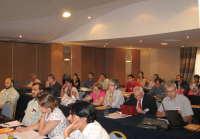 The conference was opened by Professor Carlos Brebbia who commented on the recent developments taking place at the Wessex Institute of Technology (WIT), including the building of new sports facilities, with gym and indoor swimming pool. This is – Professor Brebbia explained – part of a determined effort to improve the working environment at the Ashurst Lodge campus of WIT.
The conference was opened by Professor Carlos Brebbia who commented on the recent developments taking place at the Wessex Institute of Technology (WIT), including the building of new sports facilities, with gym and indoor swimming pool. This is – Professor Brebbia explained – part of a determined effort to improve the working environment at the Ashurst Lodge campus of WIT.
WIT – Professor Brebbia said – aims to act as an organisation dedicated to knowledge transfer at an international level. It welcomes developing links with other institutions and collaborates in many EU projects, contributing new ideas and original research in the field of computational methods, particularly boundary elements, the flagship of the Institute’s activities.
WIT also interacts – through its Industrial Research Division – with many industries throughout the world, particularly in the fields of aerospace and offshore engineering. WIT boundary elements codes are widely applied to analyse problems as varied as fracture mechanics and cathodic protection systems.
Another important activity of WIT is the dissemination of scientific and technical advanced research through its publishing arm, WIT Press, which produces 40 or so books per year (25 of them conference proceedings) and four international Journals.
Professor Brebbia concluded by inviting the delegates to discuss ways of collaborating with WIT and encouraged them to visit its campus in the New Forest to better appreciate the work of the Institute.
Keynote Addresses
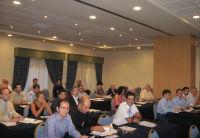 The technical sessions of the conference opened with a keynote address by Professor Jeff De Hosson on the topic of ‘Adhesion, Adhesives and Scaling' in which he discussed the way in which these problems can be analysed using computational tools. The opening address was most appropriate to discuss several important issues which are of fundamental importance to our better understanding of contact and surface engineering.
The technical sessions of the conference opened with a keynote address by Professor Jeff De Hosson on the topic of ‘Adhesion, Adhesives and Scaling' in which he discussed the way in which these problems can be analysed using computational tools. The opening address was most appropriate to discuss several important issues which are of fundamental importance to our better understanding of contact and surface engineering.
Another keynote address was delivered by Dr Iakovous Tzanakis and Professor Mark Hadfield from the University of Bournemouth in the UK, entitled ‘Evaluation of flash temperatures of a composite elastomer tip seal with dry sliding conditions in contact with a high carbon steel plate’. The work dealt with the important issue of the frictional heat generated by dry sliding contact. This allows for better predictions of wear mechanisms. Analytical results were also presented and they were compared with the experimental values indicating the importance of different parameters.
Invited Presentations
Other invited presentations that helped to enhance the conference were;
‘Improvement of corrosion resistance and bio compatibility of medical Nickel-Titanium alloys through forming TiO2 thin film’
by Y. Kimura, Kogakuin University, Japan
‘Experimental approach to eliminate start/stop defects in laser cladding’
by V. Ocelík, University of Groningen, The Netherlands
‘Computer controlled detonation spraying: a spraying process upgraded to advanced applications’
by I. Smurov, Ecole Nationale d’Ingenieurs, France
‘Flexible protective DLC films on rubber: fundamental concepts and applications’
by Y. T. Pei, University of Groningen, The Netherlands
Social Events
The conference offered the delegates many opportunities for interaction, through lunches taken together, coffee breaks and two social evenings.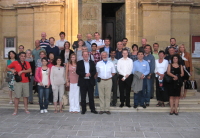 The conference dinner took place after an excursion to the island of Gozo, where the delegates were taken by ferry. Once in Gozo, they were taken by bus to Rabat, the island’s capital, where a guide explained its history and showed the places of interest, including the Basilica and Cathedral in the old town. Then they proceeded to the renown citadel, the fortified town built after Gozo was depopulated in the 1500’s by slave traders. The citadel commands a unique view of the whole island and was most effective to protect the inhabitants during the tumultuous past. It was destroyed by an earthquake and never fully rebuilt. The delegates were also shown parts of the old town and some of the sights such as the Opera House and theatre which are witness to the rich cultural heritage of the small island.
The conference dinner took place after an excursion to the island of Gozo, where the delegates were taken by ferry. Once in Gozo, they were taken by bus to Rabat, the island’s capital, where a guide explained its history and showed the places of interest, including the Basilica and Cathedral in the old town. Then they proceeded to the renown citadel, the fortified town built after Gozo was depopulated in the 1500’s by slave traders. The citadel commands a unique view of the whole island and was most effective to protect the inhabitants during the tumultuous past. It was destroyed by an earthquake and never fully rebuilt. The delegates were also shown parts of the old town and some of the sights such as the Opera House and theatre which are witness to the rich cultural heritage of the small island.
At the end of the tour they were taken to Masalforn, a coastal town with a picturesque harbour. There they had an excellent dinner in a waterfront restaurant with excellent local dishes and wines.
After dinner the delegates made their way to the bus and the ferry to take them back to the main island and the hotel.
The evening was most enjoyable and helped to strengthen the links between participants.
Visit to the University of Malta
A visit to the Faculty of Engineering of the University of Malta was arranged during the second afternoon of the conference. There they were welcomed by the Dean, Professor John Betts, who explained that although the University was set up by the Jesuits as early as 1592, the Faculty of Engineering is comparatively new.
The Faculty offers degrees in Mechanical, Metallurgical and Electrical Engineering, up to PhD level. The Mechanical Engineering Department has facilities for Computer Aided Design and is focused on helping industry. The department’s work activities range from the fundamentals of natural science to nanomaterials and biomaterials at undergraduate and postgraduate level.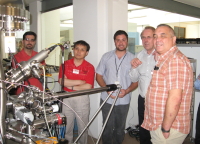 Researchers on Metallurgy and Materials Engineering work on materials characterization, biomaterials, laser methods, surface engineering, materials and archaeology. The development of dental biomaterials and studies of degradation and biocompatibility are areas of specialization.
Researchers on Metallurgy and Materials Engineering work on materials characterization, biomaterials, laser methods, surface engineering, materials and archaeology. The development of dental biomaterials and studies of degradation and biocompatibility are areas of specialization.
The group on materials and archaeology is particularly important, with the research aimed to support the numerous heritage issues present in Malta, from neolithic sites to the preservation of antique armour.
The work is supported by a series of modern laboratories which provide the resources to carry out first class research. This includes facilities and techniques such as tensile/compression testing, impact testing, micro/nano-hardness measurements, optical and electron microscopes.
Following the visit the delegates were taken to Mdina, the ancient capital of Malta which comprises a set of well preserved houses and buildings such as churches and monasteries, whose style ranges from romanesque to barooca, with hints of arabic structural forms.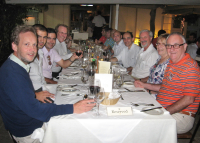 At the end of the tour of Mdina, the Wessex Institute invited the participants to a dinner in a well-known Trattoria within the walls of the ancient fortress. There they had a meal consisting of local dishes accompanied by excellent wines.
At the end of the tour of Mdina, the Wessex Institute invited the participants to a dinner in a well-known Trattoria within the walls of the ancient fortress. There they had a meal consisting of local dishes accompanied by excellent wines.
The visit and following dinner were most successful in bringing the work of the University of Malta researchers to the attention of the delegates. It also helped to further strengthen the links amongst the participants.
The success of the conference will ensure that it is reconvened at a date and location to the shortly announced.
Publication of Proceedings
The proceedings of Surface Effects and Contact Mechanics X, 320pp (Print ISBN: 978-1-84564-530-4; Online ISSN: 1746-4471) are available in paper and digital format from WIT Press priced at £138/US$276/€193. Orders can be placed on the WIT Press web site at www.witpress.com or by email:
Papers from the conference will also be hosted online at the WIT eLibrary as Volume 71 of WIT Transactions on Engineering Sciences (Online ISSN: 1746-4471). For more details visit the WIT eLibrary at http://library.witpress.com


 Wessex Institute
Wessex Institute